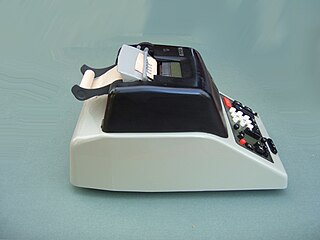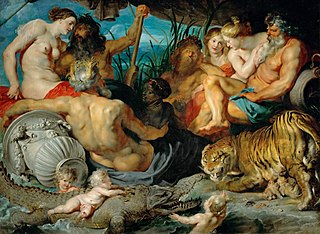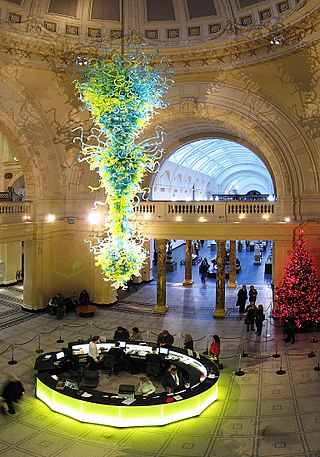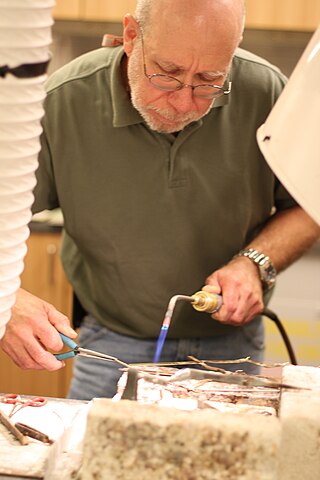Related Research Articles

A handicraft, sometimes more precisely expressed as artisanal handicraft or handmade, is any of a wide variety of types of work where useful and decorative objects are made completely by one's hand or by using only simple, non-automated related tools like scissors, carving implements, or hooks. It is a traditional main sector of craft making and applies to a wide range of creative and design activities that are related to making things with one's hands and skill, including work with textiles, moldable and rigid materials, paper, plant fibers, clay, etc. One of the oldest handicraft is Dhokra; this is a sort of metal casting that has been used in India for over 4,000 years and is still used. In Iranian Baluchistan, women still make red ware hand-made pottery with dotted ornaments, much similar to the 5,000-year-old pottery tradition of Kalpurgan, an archaeological site near the village. Usually, the term is applied to traditional techniques of creating items that are both practical and aesthetic. Handicraft industries are those that produce things with hands to meet the needs of the people in their locality without using machines.

In European academic traditions, fine art is made primarily for aesthetics or creative expression, distinguishing it from decorative art or applied art, which also has to serve some practical function, such as pottery or most metalwork. In the aesthetic theories developed in the Italian Renaissance, the highest art was that which allowed the full expression and display of the artist's imagination, unrestricted by any of the practical considerations involved in, say, making and decorating a teapot. It was also considered important that making the artwork did not involve dividing the work between different individuals with specialized skills, as might be necessary with a piece of furniture, for example. Even within the fine arts, there was a hierarchy of genres based on the amount of creative imagination required, with history painting placed higher than still life.

Industrial design is a process of design applied to physical products that are to be manufactured by mass production. It is the creative act of determining and defining a product's form and features, which takes place in advance of the manufacture or production of the product. It consists purely of repeated, often automated, replication, while craft-based design is a process or approach in which the form of the product is determined by the product's creator largely concurrent with the act of its production.

The decorative arts are arts or crafts whose object is the design and manufacture of objects that are both beautiful and functional. It includes most of the arts making objects for the interiors of buildings, and interior design, but not usually architecture. Ceramic art, metalwork, furniture, jewellery, fashion, various forms of the textile arts and glassware are major groupings.

Folk art covers all forms of visual art made in the context of folk culture. Definitions vary, but generally the objects have practical utility of some kind, rather than being exclusively decorative. The makers of folk art are typically trained within a popular tradition, rather than in the fine art tradition of the culture. There is often overlap, or contested ground with 'naive art'. "Folk art" is not used in regard to traditional societies where ethnographic art continue to be made.

A work of art, artwork, art piece, piece of art or art object is an artistic creation of aesthetic value. Except for "work of art", which may be used of any work regarded as art in its widest sense, including works from literature and music, these terms apply principally to tangible, physical forms of visual art:

American craft is craft work produced by independent studio artists working with traditional craft materials and processes. Examples include wood, glass, clay (ceramics), textiles, and metal (metalworking). Studio craft works tend to either serve or allude to a functional or utilitarian purpose, although they are just as often handled and exhibited in ways similar to visual art objects.

Wendell Castle was an American sculptor and furniture maker and an important figure in late 20th century American craft. He has been referred to as the "father of the art furniture movement" and included in the "Big 4" of modern woodworking with Wharton Esherick, George Nakashima, and Sam Maloof.

Art jewelry is one of the names given to jewelry created by studio craftspeople. As the name suggests, art jewelry emphasizes creative expression and design, and is characterized by the use of a variety of materials, often commonplace or of low economic value. In this sense, it forms a counterbalance to the use of "precious materials" in conventional or fine jewelry, where the value of the object is tied to the value of the materials from which it is made. Art jewelry is related to studio craft in other media such as glass, wood, plastics and clay; it shares beliefs and values, education and training, circumstances of production, and networks of distribution and publicity with the wider field of studio craft. Art jewelry also has links to fine art and design.

Studio craft is the practice of craft methodology in an artist's studio. Traditional craft tends to generate craft objects out of necessity or for ceremonial use while studio craft produces craft objects at the whim of the maker or intended owner. These objects are at most only desirable for use and often lack any utility. Because studio craft doesn't make objects out of necessity, it is similar to works of studio art which are made for aesthetic rather than functional purposes.
Jere Osgood is an American studio furniture maker, and teacher of furniture and woodworking. He taught for many years in the Boston University Program in Artisanry.
The Furniture Society, founded in 1996, is a membership-based, tax-exempt 501(c)(3) nonprofit corporation working to advance the art of furniture making by inspiring creativity, promoting excellence and fostering understanding of this art. The Society, based in Asheville, North Carolina, has an international membership comprising furniture makers, designers, educators, museum and gallery professionals, scholars, journalists, collectors, students and the interested public.

Rosanne Somerson is an American-born woodworker, furniture designer/maker, educator, and former President of Rhode Island School of Design (RISD). An artist connected with the early years of the Studio Furniture, her work and career have been influential to the field.

Critical making refers to the hands-on productive activities that link digital technologies to society. It was invented to bridge the gap between creative, physical, and conceptual exploration. The purpose of critical making resides in the learning extracted from the process of making rather than the experience derived from the finished output. The term "critical making" was popularized by Matt Ratto, an associate professor at the University of Toronto. Ratto describes one of the main goals of critical making as a way "to use material forms of engagement with technologies to supplement and extend critical reflection and, in doing so, to reconnect our lived experiences with technologies to social and conceptual critique." "Critical making", as defined by practitioners like Matt Ratto and Stephen Hockema, "is an elision of two typically disconnected modes of engagement in the world — "critical thinking," often considered as abstract, explicit, linguistically based, internal and cognitively individualistic; and "making," typically understood as tacit, embodied, external, and community-oriented."

A mount maker is responsible for the creation of structures called object mounts used to provide unobtrusive physical support, stability, and security of objects while on display, in storage, or being transported to museums, art galleries, libraries, archives, botanical gardens or other cultural institutions. Protection and long-term conservation of the object is a key goal of mount makers. This is accomplished through careful design, selection of materials and manufacturing process that will not inadvertently harm the object, and a cautious installation process of the object into its place in an exhibit. Professionals in this field can be employed directly by an institution, be independent contractors, or work as part of larger cultural institution exhibit design firms.
Eudorah Moore was an American curator and patron of the arts. She is regarded as revolutionizing California design and for her advocacy of craft as an art form.
Wendy Maruyama is an artist, furniture maker, and educator from California. She was born in La Junta, Colorado.

Folk and traditional arts are rooted in and reflective of the cultural life of a community. They encompass the body of expressive culture associated with the fields of folklore and cultural heritage. Tangible folk art includes historic objects which are crafted and used within a traditional community. Intangible folk arts include forms such as music, dance and narrative structures. Tangible and intangible folk arts were developed to address a need, and are shaped by generational values derived from family and community, through demonstration, conversation and practice.
Annie Evelyn is a furniture designer and artist known for works that combine an innovative use of materials with humor. She is co-founder of Table Fights.
Aspen Golann is an American woodworker who produces furniture.
References
- 1 2 "Made in Massachusetts: Studio Furniture of the Bay State - Fuller Craft Museum". Fuller Craft Museum. 2013-07-31. Retrieved 2017-12-18.
- 1 2 "American Studio Craft Movement | Artsy". www.artsy.net. Retrieved 2017-12-18.
- ↑ Fitzgerald, Oscar P. (2008). Studio furniture of the Renwick Gallery, Smithsonian American Art Museum. Smithsonian American Art Museum. East Petersburg: Fox Chapel Pub. ISBN 9781565233652. OCLC 163603707.
- ↑ Mind & hand : contemporary studio furniture. Aslund, Jean., Congdon-Martin, Douglas., Furniture Society., Furniture Society. Conference (2010 : Massachusetts Institute of Technology). Atglen, Pa.: Schiffer Pub. 2012. ISBN 9780764341151. OCLC 768166946.
{{cite book}}: CS1 maint: others (link) - ↑ "Homepage". The Furniture Society. Retrieved 2019-10-15.
- ↑ Risatti, Howard Anthony. A theory of craft: function and aesthetic expression. The University of North Carolina Press, 2007